While there are places in the world called "blue zones", where people live longer, up to 100 years, perhaps because of the low prevalence of chronic diseases among them;
Life expectancy in the United States has seen its sharpest decline since the 1920s, decreasing in the past two years from 77 to 76.1 years, according to the Center for Disease Control (CDC).
Certified health nutritionist Caitlin McAfee attributes this decrease to "an increase in the incidence of chronic diseases";
Six out of 10 adults in the country suffer from at least one chronic health condition, which includes heart disease, diabetes and cancer, in contrast to 4 out of 10 who suffer from two or more conditions.
But Dan Buettner, the best-selling American journalist and author - according to the New York Times classification - maintains that the main reason for the longevity of the residents of the Blue Zones is brisk walking.
Dan Buettner is an Emmy Award-winning documentary producer and adventurous cyclist who traveled around the world, breaking 3 Guinness World Records, to explore the secrets of living longer lives, before founding Bluezones to help people around the planet live healthier, longer lives. longer.
Remember that walking - even a little bit - is better than not walking and the need to walk at least 10 minutes a day (Shutterstock)
Better physical activity for health and longevity
Although many studies "link regular exercise - even small daily movements - with living a longer life";
Buettner has concluded that brisk walking is the best physical activity for optimal health and longevity.
Citing residents in Okinawa, Japan, Loma Linda, California, Sardinia, Italy, and other regions of the world, some of whom are 110 years old, "they have a common denominator: brisk walking and intense physical activity."
He found that regular movement is an integral part of the culture and way of life in the Blue Zones, as they move every 20 minutes, and even exploit their environment in a way that prompts them to move, according to Buettner.
In the context, the Harvard Medical School website states that “just walking can do wonders for your health,” as this sport is simple yet powerful, and “helps maintain fitness, improve cholesterol levels, strengthen bones, control blood pressure, and raise mood, and reduce the risk of developing a number of diseases, such as diabetes and heart disease.
You can walk daily for the rest of your life
Not only is walking something that you can include in your day and enjoy easily, but "because you can also continue to do it until your 100th birthday, and maybe beyond," says Buettner.
Brisk walking exercises all parts of your body, through rapid breathing or sweating, for 5 to 10 hours a week, and it can provide you with about 90% of the physical activity benefits of marathon training, but with less effort;
It engages more than 100 muscles, and improves cognitive functions.
Research indicated that "doing simple movements during the day can build muscle mass that support longevity more than doing a difficult sports session at once";
It linked walking just 10 minutes a day to "increased longevity in people 85 or older".
Walking is also a training technique that keeps your heart rate between 60 and 70% of your maximum, "for a period to build cardiovascular endurance";
This is what certified personal trainer Jonathan Olonade calls "longevity."
But Buettner warns that by brisk walking he does not mean "running a weekly marathon", but believes that the best is not to overdo it, because "exhausting your body with exercise until you feel pain is not a good idea; it may eventually lead to damage to the knees, hips and joints."
Brisk walking exercises all parts of your body through rapid breathing or sweating for 5 to 10 hours a week (Deutsche Welle)
Get the most out of walking
To get the most out of walking, Buettner and other experts recommend:
walking briskly for an hour a day,
which is an easily achievable goal;
By choosing a coffee shop or restaurant 15 minutes away from your work, for example, and going back and forth twice a day.
Or by making sure to walk instead of using the car on the weekends.
Or jog for 30 to 40 minutes every other day, plus two hours on weekends.
A study that followed about 75,000 runners for 7 years showed that running reduces weight and prevents osteoporosis.
Use your muscles,
after man has evolved by using his muscles all the time to walk, run, climb trees and climb hills, he uses elevators and escalators, drives cars instead of walking, relies on washing machines and dishwashers instead of making efforts to wash dishes and clothes, and buys food instead of getting tired his cultivation, and hires other people to do minor household repairs rather than fixing it himself.
So, it's time to use every muscle in the body frequently, because muscles grow and gain strength through effort and challenge.
Try walking on the ground with bare feet.
It may seem strange, but one study found that it "positively affects the electrical activity in the brain."
Make sure you're walking properly
. After you've stocked up on a good pair of supportive walking shoes, make sure you shorten your steps, lean slightly forward, and alternate your arms and legs as you walk, as recommended by yoga instructor Jonathan Fitzgordan.
Remember that even a little walking is better than no walking.
You should try to walk at least 10 minutes a day, which is better than not walking at all, says personal trainer Chris Goldman.
Dietitian Caitlin McAfee also advises, saying, "If you are not moving enough, let your first goal be to walk 15 minutes every day, while the Harvard Medical School website recommends gradually walking from 15 to 30 to 60 minutes most days of the week."

